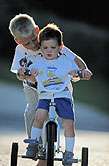Kids more likely to pick up warts at home, not public spaces

(HealthDay)—Contrary to conventional wisdom, a new Dutch study has found that the most likely way children get infected with the virus that causes warts is from close contact with family members or classmates, rather than from public places such as pools or communal showers.
The researchers concluded that a widespread public health focus on encouraging kids to cover their warts with bandages when swimming or to wear flip-flops when using public showers does not address the primary source of wart infection.
To come to this conclusion, the study authors spent 18 months tracking wart occurrences among roughly 1,100 Dutch children enrolled in grades 1 through 7 (aged 4 to 12), all of whom were attending one of three different primary schools in Leiden, Netherlands.
"Current recommendations on wart prevention focus primarily on public places such as swimming pools," said lead author Dr. Sjoerd Bruggink, from the department of public health and primary care at Leiden University Medical Center. "[But] children often get warts from family members or classmates rather than from public spaces, [suggesting that] covering warts at home or at school could maybe be more helpful in preventing warts."
The Dutch team reported its findings online April 22 and in the May print issue of the journal Pediatrics.
Warts are caused by certain strains of the human papilloma virus (HPV); they are not the same as genital warts, which are transmitted sexually and raise the risk for cervical cancer.
To get a handle on what drives the spread of warts among grade school kids, the authors examined the hands and feet of all the participating children during an 11- to 18-month period. In addition, parents were asked to complete questionnaires indicating both their child's use of public facilities, time spent playing sports and the presence of warts among family members and close friends.
The result: The team determined that the real risk for spreading warts came from exposure to people in their home or classroom who had warts, not through the use of public spaces.
Bruggink's team suggested that public health efforts should place a greater focus on the risk that comes from such relatively intimate contact, rather than on the hazards of communal environments.
Practically speaking, such a shift in approach would not necessarily involve a radical change, they said. Rather, it would mean, for example, that children should be encouraged to cover their warts with bandages while at home, rather than when going for a swim.
Dr. Joceyln Glassberg, an obstetrician and gynecologist at Scott and White Healthcare in Round Rock, Texas, said she believes the Dutch team's observations accurately reflect the nature of how HPV is actually spread.
"The study findings make sense since HPV is a contact-borne virus, and children have the most contact with their household members and school friends," she said. "It is a great reminder that if anyone has a wart [they should] cover it to prevent spreading the virus."
More information:
For more on the human papilloma virus, visit the U.S.
National Institutes of Health.
Abstract
Full Text (subscription or payment may be required)
Health News Copyright © 2013 HealthDay. All rights reserved.
















